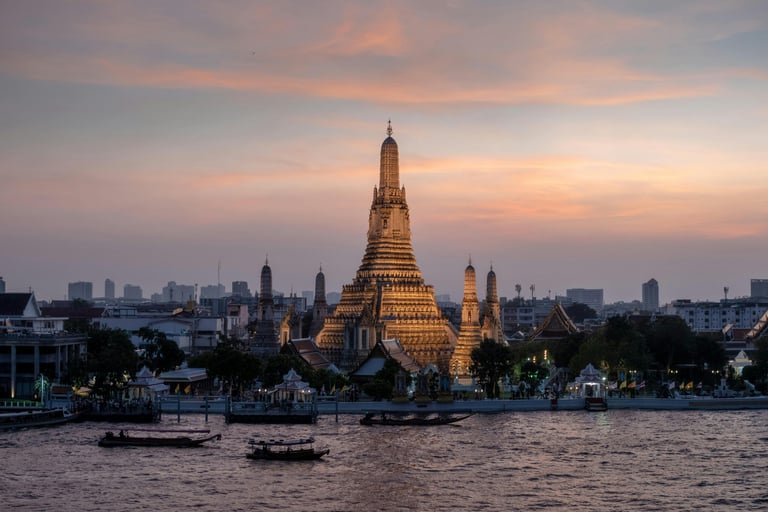Bangkok – City of Golden Temples
Step into Bangkok, where golden temples, vibrant street life, and timeless tradition create a city of dazzling contrasts.
DESTINATIONS
Jetsclusive
6/28/20255 min read
Bangkok – City of Golden Temples
From sunrise to sunset, Bangkok dazzles with its golden spires piercing the sky and its centuries-old temples glowing in the tropical sun. This is more than a city; it’s a living canvas of Thai heritage, Buddhist spirituality, and vivid artistry. Over 400 Buddhist temples, called wats, shape the heart and soul of Bangkok, making it a city that lives up to its famed nickname: the City of Golden Temples. Each wat has a story—part myth, part history—that defines the city’s character and draws millions of curious visitors and devoted pilgrims every year.
These temples offer more than lavish art and architecture; they’re living spaces of worship, teaching, and celebration. They serve as a bridge between ancient tradition and modern city life, inviting everyone inside to breathe in the calm and grandeur of Thai culture.
Bangkok’s Most Iconic Temples and Their Stories
Step into Bangkok and you’ll find yourself surrounded by iconic temples, each with legendary roots and intricate craftsmanship. These wats stand out not just as tourist attractions, but as powerful symbols of Thai identity.
Wat Phra Kaew: Heart of Thai Spirituality
At the center of the Grand Palace complex stands Wat Phra Kaew, the Temple of the Emerald Buddha. Revered as the spiritual core of Thailand, this temple houses a small but mighty Buddha statue, carved from a single piece of jade. Its exact origin is steeped in legend, travelling from India through Laos before finding its home here in 1784.
Wat Phra Kaew’s murals blanket the walls with stories from Buddhist lore and Thai mythology, creating a sense of timeless narrative. No monks reside here; instead, it acts as the royal chapel, a place for national ceremonies and spiritual reflection.
Fun fact: The Emerald Buddha’s golden outfits are changed three times a year by the King himself, marking the change of seasons in Thai tradition.
Wat Pho: Sanctuary of the Reclining Buddha and Thai Massage
Just steps from the Grand Palace stands Wat Pho, famous for its breathtaking Reclining Buddha. Measuring 46 meters long and covered in gold leaf, the statue’s serene gaze and intricate mother-of-pearl feet draw thousands daily. Wat Pho is also home to the nation’s largest collection of Buddha images.
But Wat Pho’s story doesn’t stop there. It’s the birthplace of traditional Thai massage—here, you can see detailed murals about medicine and massage, or even book a massage from the temple’s skilled practitioners. This makes Wat Pho both a sanctuary of wellness and a guardian of ancient wisdom.
Compare Private Pricing To Bangkok Here Powered By Villiers Jets - Trusted by 1,000+ flyers worldwide
Wat Arun: Temple of Dawn’s Radiance
Wat Arun, sitting on the banks of the Chao Phraya River, is impossible to miss. Its towering central prang (spire) shimmers, covered with bits of colored porcelain and seashells that sparkle in the morning light. Known as the Temple of Dawn, Wat Arun’s design draws from Hindu myths; the central prang represents Mount Meru, the center of the universe.
The climb up the steep staircase rewards the brave with sweeping views of the river and city beyond—a moment that captures both the calm and energy of Bangkok itself.
Wat Saket: The Golden Mount and Festival Traditions
Wat Saket, or the Golden Mount, is where Bangkok rises above itself. Built atop an artificial hill, its golden chedi (stupa) towers over the old city. Ascend its winding staircase, ring the prayer bells, and reach a panoramic terrace overlooking the city’s rooftops and temple spires.
Each November, Wat Saket becomes the heart of the temple fair. Locals and visitors join candlelit processions, transforming the Golden Mount into a beacon of light and community spirit.
Wat Traimit: Home of the Golden Buddha
Wat Traimit holds a surprise: the world’s largest solid gold Buddha. Weighing 5.5 tons and standing nearly three meters high, this statue’s gleaming surface masks a fascinating story. Once sealed in plaster to hide it from invading armies, the gold was only revealed by accident in the 1950s when movers dropped the statue and the coating cracked. Today, Wat Traimit is a testament to both faith and fortune, its golden icon visited by those who seek inspiration or simply want to stand in awe.
The Role of Temples in Bangkok’s Cultural and Daily Life
Bangkok’s temples aren’t just relics of the past—they’re active centers of worship, creativity, and togetherness. They shape daily routines, inspire art, and tie communities together.
Compare Private Jet Pricing To Bangkok Here Powered By Villiers Jets - Trusted by 1,000+ flyers worldwide
Temple Etiquette: Respect, Dress Codes, and Rituals
Visiting a wat is an act of respect. Temples ask visitors to dress modestly: shoulders and knees covered, hats off, and shoes left at the door. Simple gestures matter—keep your feet pointed away from Buddha images, speak quietly, and never touch sacred objects unless invited.
When in doubt, follow the lead of locals: a respectful bow (the wai), gentle movements, and open-hearted curiosity go a long way.
Key etiquette tips:
Wear clothing that covers knees and shoulders.
Remove shoes before entering temple buildings.
Avoid public displays of affection or loud voices.
Never point your feet at Buddha statues.
Ask before taking photographs.
Temples as Community Centers and Cultural Custodians
Beyond their spiritual role, many wats function as community centers. Locals gather for meditation, art classes, and almsgiving. Laypeople volunteer, monks teach, and the temple grounds echo with festivals and family gatherings.
Temples preserve traditions through art—murals, music, and dance—while offering free classes in everything from Sanskrit to sculpture. In this way, the wat acts as a living museum and classroom, passing knowledge from one generation to the next.
Festivals, Ceremonies, and Everyday Spiritual Practices
Nearly every Thai festival includes temple ceremonies. Songkran (Thai New Year), Loy Krathong (Festival of Lights), and Buddhist Lent see temples adorned with flowers, candles, and vibrant processions. Daily life revolves around spiritual rituals: offering food to monks at sunrise, lighting incense, and reciting prayers for luck, health, and protection.
Visitors can join in these rituals—just watch, listen, and participate respectfully. The sound of chanting, the scent of lotus and incense, and the sight of saffron-robed monks create lasting memories of Bangkok’s beating spiritual heart.
Conclusion
Bangkok earns its title as the City of Golden Temples not just through the glitter of gilded stupas but through the living energy and warmth of its wats. Here, ancient legends meet daily life, and faith is etched into every mosaic and mural.
For visitors, these temples offer more than postcard photos—they promise moments of peace, discovery, and insight. Dress politely, move with respect, and let the city’s golden temples share their stories with you. In doing so, you’ll carry home a piece of Bangkok’s spirit—shining and timeless.


Luxury
Explore the world of private aviation and travel.
support@jetsclusive.net
© 2025. All rights reserved.
